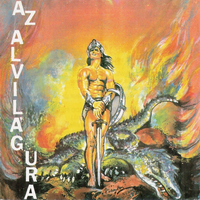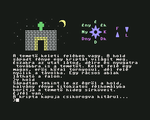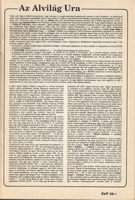My
third adventure was Az Alvilág Ura (or its „original”
title Lord Of The Hell 2.). The historical circumstances
of its born (and its little unfortunate after-life) were also
exhaustively dissected along  at
another place by me (who is interested please see there). In another
respect, however, it was the first: the first one to be bought
and retailed, and becoming known outside my personal environment,
too. (Therefore the first which reached anything so-called „professionally”.)
It deserved this almost by my half and a year developing work;
it was fully made in Assembly (or, in machine code, that’s approximately
the same in the case of C64). (If I was to make this as a more
routinish, experienced programmer a few years later, I should
have got down with that within a far less time of course; but
some such comparisons usually are practically of not too much
use as just exactly that labour is what gives birth to the experience,
and finally the time and effort are applied to this.) The program
was bought and released by the Novotrade Rt.; the one
and only „absolute ruler” company in Hungary about that time at
software trade.
at
another place by me (who is interested please see there). In another
respect, however, it was the first: the first one to be bought
and retailed, and becoming known outside my personal environment,
too. (Therefore the first which reached anything so-called „professionally”.)
It deserved this almost by my half and a year developing work;
it was fully made in Assembly (or, in machine code, that’s approximately
the same in the case of C64). (If I was to make this as a more
routinish, experienced programmer a few years later, I should
have got down with that within a far less time of course; but
some such comparisons usually are practically of not too much
use as just exactly that labour is what gives birth to the experience,
and finally the time and effort are applied to this.) The program
was bought and released by the Novotrade Rt.; the one
and only „absolute ruler” company in Hungary about that time at
software trade.
It
became my firm and unshakeable intention by then to have each
another next throw possibly an order of magnitude greater than
the previous. (Technically I was still able to keep the pace required
at least.) The „tragedy” of my exponential challenge did not seem
yet, and although the powerless „body” did not follow the spirit
becoming ready to act too early in several further respects yet,
either (e. g. the graphical display of the program was still modest,
and a little bit of amaterish,  too),
I had already seen not the present moment on looking
at it long since, but always that which would come after
this soon later. (I also caught this thought of mine having become
a bit scary in this infinite form successfully in a graphical
vision a few years later; yes, it was that ominous skeleton picture,
see
too),
I had already seen not the present moment on looking
at it long since, but always that which would come after
this soon later. (I also caught this thought of mine having become
a bit scary in this infinite form successfully in a graphical
vision a few years later; yes, it was that ominous skeleton picture,
see  there.)
there.)
 If
now – subsequently and with cruelty – we deprive that of this
idealized clothes, then the result will be rather grayer, more
average and insignificant. As compared to the average performances
attained by the contemporary Hungarian computer gaming subculture
(and within that semi-amateurish, home-made game-developing movement
appearing those years), and mostly to its uneven and discordant
standard (as finally being some natural and original substance
of my games, too, as so having to be compared first to that),
it definitely took place among the best (and relatively also would
have emerged from among them much more, unless being accompanied
consequently along by the ill-fate on all my trying to make it
popular).
If
now – subsequently and with cruelty – we deprive that of this
idealized clothes, then the result will be rather grayer, more
average and insignificant. As compared to the average performances
attained by the contemporary Hungarian computer gaming subculture
(and within that semi-amateurish, home-made game-developing movement
appearing those years), and mostly to its uneven and discordant
standard (as finally being some natural and original substance
of my games, too, as so having to be compared first to that),
it definitely took place among the best (and relatively also would
have emerged from among them much more, unless being accompanied
consequently along by the ill-fate on all my trying to make it
popular).
However
I measured myself not to this, but the international examples
were floating before my eyes. Since as being a talented student
I had got some unlimited possibilities with no responsibility
lied upon me (as being a first rate pupil at my schools I only
walked in daily, and so all remaining time and energy might be
invested into my own aims), I set myself any target with a light
heart at my  will.
Adventure games became the main „hits” of the age, and several
factors contributed to it. On the one hand, the capabilities of
the computers (or, to be more exact, their limits): the
processing speed and the graphical knowledge stood at a very initial
stage inspected with a modern eye. (Thus, rather such games were
to be developed, which did not lean on this, but upon the ideas,
the creativity and fancy instead.) On the other hand, game development
itself still in its entirety rated as a relatively young industry
and/or creative activity sphere with countless unexploited possibilities
and evolving ways. Besides, there was even a third constituent
present, the openness: the cultivation of the adventure genre
might already be started at an extraordinarily low and wantless
level (both considering as a quality standard, as a material or
financial sacrifice by this), so moreover anyone could
score the first success with ease in it – and thenceforward no
bounds at all. (And naturally everybody wished that: there and
then – so immediately and forthwith – entering into something
in which he or she could grow till any highest level later on.)
And another fourth point of view again: adventure is an intellectual
and intelligent genre – not only its making, but its playing,
too.
will.
Adventure games became the main „hits” of the age, and several
factors contributed to it. On the one hand, the capabilities of
the computers (or, to be more exact, their limits): the
processing speed and the graphical knowledge stood at a very initial
stage inspected with a modern eye. (Thus, rather such games were
to be developed, which did not lean on this, but upon the ideas,
the creativity and fancy instead.) On the other hand, game development
itself still in its entirety rated as a relatively young industry
and/or creative activity sphere with countless unexploited possibilities
and evolving ways. Besides, there was even a third constituent
present, the openness: the cultivation of the adventure genre
might already be started at an extraordinarily low and wantless
level (both considering as a quality standard, as a material or
financial sacrifice by this), so moreover anyone could
score the first success with ease in it – and thenceforward no
bounds at all. (And naturally everybody wished that: there and
then – so immediately and forthwith – entering into something
in which he or she could grow till any highest level later on.)
And another fourth point of view again: adventure is an intellectual
and intelligent genre – not only its making, but its playing,
too.
Therefore
when I wrote Az Alvilág Ura, then my models were the
world famous Magnetic Scrolls games (and especially the
first one of them, The Pawn caught my attention the most).
In practice, of  course,
I was only equal more or less to that for the time being, but
I began to powerfully aspire after that. Since the difficulties
of the English and the Hungarian text interpreting (as the grammar
being strongly dissimilar in them) might set some rather different
tasks, I still had to work out my own solution to the entire question.
course,
I was only equal more or less to that for the time being, but
I began to powerfully aspire after that. Since the difficulties
of the English and the Hungarian text interpreting (as the grammar
being strongly dissimilar in them) might set some rather different
tasks, I still had to work out my own solution to the entire question.
 Contemporaneously
I never attached any great importance to the story contained within
the plot of any game, as I also emphasized that from the very
beginning, and it finally resulted in my often tortuous, twisted,
meandering and disconnected seeming dramaturgic tangles and intricacies
– exactly because of being born this way, namely I indiscriminately
and unmethodically took down any kinds of ideas which crossed
my mind, and moulded these all together as a „story” in an open-handed,
large-scale, spontaneous way. I absolutely did not take this part
of the programming seriously; albeit in a manner – namely considering
as the reachable non-linearity level of the plot – still shared
a significant part of my philosophy. (The solution of Az Alvilág
Ura was formerly published in CoV 16, therein it could be
followed all along; likewise at the webpage of the game.)
Contemporaneously
I never attached any great importance to the story contained within
the plot of any game, as I also emphasized that from the very
beginning, and it finally resulted in my often tortuous, twisted,
meandering and disconnected seeming dramaturgic tangles and intricacies
– exactly because of being born this way, namely I indiscriminately
and unmethodically took down any kinds of ideas which crossed
my mind, and moulded these all together as a „story” in an open-handed,
large-scale, spontaneous way. I absolutely did not take this part
of the programming seriously; albeit in a manner – namely considering
as the reachable non-linearity level of the plot – still shared
a significant part of my philosophy. (The solution of Az Alvilág
Ura was formerly published in CoV 16, therein it could be
followed all along; likewise at the webpage of the game.)
That
stage of development appearing in the program thus composed one
grade of the way leading to the target set before. Of Hungarian
games preceding to that it was not typical to stress the importance
of grammar and word-inflexion to increasingly concrete; or a dialogue-like
operating mode (the program asks for the missing elements of sentence,
so you may further rectify that later). I also made much account
of such constitutes, for example to let each and every item be
able to be examined (or having any individually composed description
at least); or the positioning of the objects and their placement
according to each other be as real, as shaded and verisimilar
as possible… (That’s the so-called layeredness.) Be logical
„idle running” or some „vacant run” within the least possible
(those such probable, supposable acting combinations which the
algorhythms are not previously prepared for); still notwithstanding
relatively be the freedom to do somehow the widest possible.
| |
 |
Az
Alvilág Ura |
09/01/2011 |
 |
 |
| |
Skeletons,
crypts and dead /2. (1990) |
|

